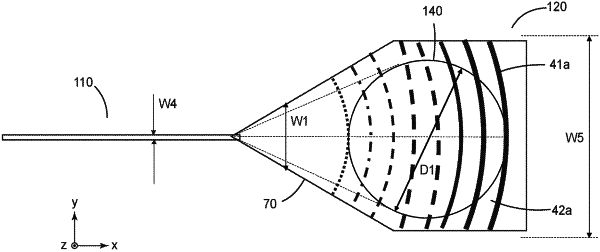| CPC G02B 6/305 (2013.01) [G02B 6/124 (2013.01); G02B 6/34 (2013.01)] | 10 Claims |

|
1. An optical waveguide for propagating an optical mode at a first wavelength along a length of the waveguide, comprising:
an optical core having a substantially polygonal cross-section in a plane substantially perpendicular to the length of the waveguide, the optical core having an index of refraction n1 at the first wavelength;
a first optical cladding disposed adjacent the optical core and having an index of refraction n2 at the first wavelength, n2<n1;
a spatially modulated index region comprising alternating higher and lower index regions extending along a width, and arranged along the length, of the optical waveguide, and configured to extract an optical mode that would otherwise propagate along the length of the waveguide, the spatially modulated index region having a length L along the length of the waveguide greater than about 30 microns, wherein a rate of change of n1 with temperature T is Δn1/ΔT, a rate of change of silicon with temperature T is Δn(Si)/ΔT, Δn1/ΔT<Δn(Si)/ΔT;
first and second optical waveguide portions sequentially arranged along the length of the waveguide, wherein the first optical waveguide portion is single-mode at the first wavelength, and the second optical waveguide portion is capable of supporting multiple optical modes at the first wavelength, such that an optical single-mode propagating along the first waveguide portion, excites substantially only a fundamental optical mode of the second waveguide portion, the excited fundamental optical mode propagating along the second waveguide portion; and
a transition region connecting the first and second optical waveguide portions, the transition region gradually increasing in width in a direction from the first optical waveguide portion to the second optical waveguide portion, wherein the width of the transition region is governed by the equation: W1=Wo+2A Sin2(πx/T), wherein Wo is the width of the transition region at the first optical waveguide portion, A is a constant, x is the length of the optical waveguide, and T is a length of the transition region along the length of the optical waveguide, and wherein A is in a range from about 3 microns to about 75 microns.
|